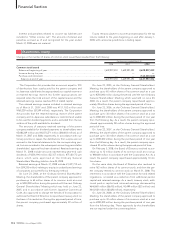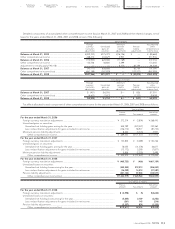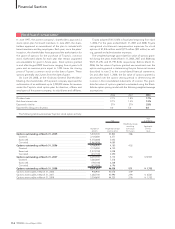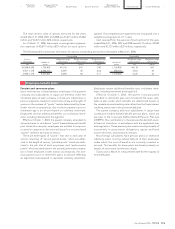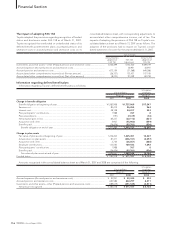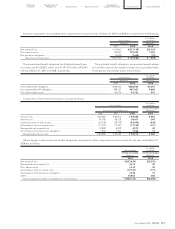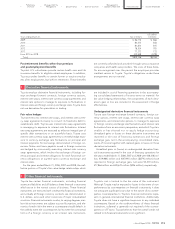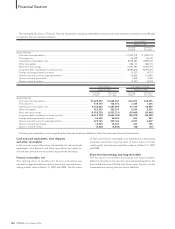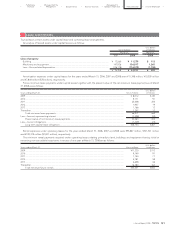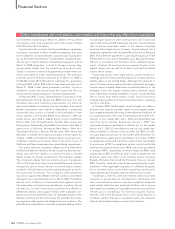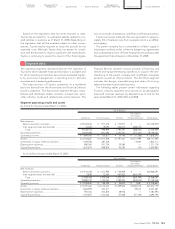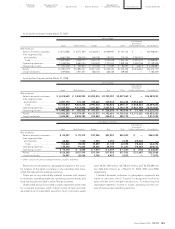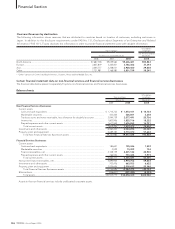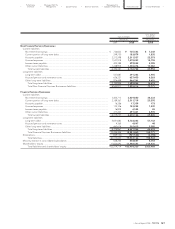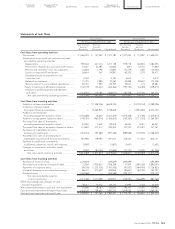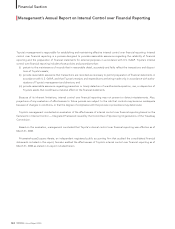Toyota 2008 Annual Report Download - page 124
Download and view the complete annual report
Please find page 124 of the 2008 Toyota annual report below. You can navigate through the pages in the report by either clicking on the pages listed below, or by using the keyword search tool below to find specific information within the annual report.
122 TOYOTA •Annual Report 2008 •
Financial Section
Commitments outstanding at March 31, 2008 for the purchase
of property, plant and equipment and other assets totaled
¥173,720 million ($1,734 million).
Toyota enters into contracts with Toyota dealers to guarantee
customers’ payments of their installment payables that arise
from installment contracts between customers and Toyota deal-
ers, as and when requested by Toyota dealers. Guarantee peri-
ods are set to match maturity of installment payments, and at
March 31, 2008, range from 1 month to 35 years; however, they
are generally shorter than the useful lives of products sold.
Toyota is required to execute its guarantee primarily when cus-
tomers are unable to make required payments. The maximum
potential amount of future payments as of March 31, 2008 is
¥1,460,362 million ($14,576 million). Liabilities for guarantees
totaling ¥3,905 million ($39 million) have been provided as of
March 31, 2008. Under these guarantee contracts, Toyota is
entitled to recover any amount paid by Toyota from the cus-
tomers whose original obligations Toyota has guaranteed.
In February 2003, Toyota, General Motors Corporation, Ford,
DaimlerChrysler, Honda, Nissan and BMW and their U.S. and
Canadian sales and marketing subsidiaries, the National
Automobile Dealers Association and the Canadian Automobile
Dealers Association were named as defendants in purported
nationwide class actions on behalf of all purchasers of new
motor vehicles in the United States since January 1, 2001. 26
similar actions were filed in federal district courts in California,
Illinois, New York, Massachusetts, Florida, New Jersey and
Pennsylvania. Additionally, 56 parallel class actions were filed in
state courts in California, Minnesota, New Mexico, New York,
Tennessee, Wisconsin, Arizona, Florida, Iowa, New Jersey and
Nebraska on behalf of the same purchasers in these states. As
of April 1, 2005, actions filed in federal district courts were con-
solidated in Maine and actions filed in the state courts of
California and New Jersey were also consolidated, respectively.
The nearly identical complaints allege that the defendants
violated the Sherman Antitrust Act by conspiring among them-
selves and with their dealers to prevent the sale to United
States citizens of vehicles produced for the Canadian market.
The complaints allege that new vehicle prices in Canada are
10% to 30% lower than those in the United States and that pre-
venting the sale of these vehicles to United States citizens
resulted in United States consumers paying excessive prices for
the same type of vehicles. The complaints seek permanent
injunctions against the alleged antitrust violations and treble
damages in an unspecified amount. In March 2004, the federal
district court of Maine (i) dismissed claims against certain
Canadian sales and marketing subsidiaries, including Toyota
Canada, Inc., for lack of personal jurisdiction but denied or
deferred to dismiss claims against certain other Canadian com-
panies, and (ii) dismissed the claim for damages based on the
Sherman Antitrust Act but did not bar the plaintiffs from seek-
ing injunctive relief against the alleged antitrust violations. The
plaintiffs have submitted an amended compliant adding a claim
for damages based on state antitrust laws and Toyota has
responded to the plaintiff’s discovery requests. Toyota believes
that its actions have been lawful. In the interest of quickly
resolving these legal actions, however, Toyota entered into a
settlement agreement with the plaintiffs at the end of February
2006. The settlement agreement is pending the approval of the
federal district court, and immediately upon approval the plain-
tiffs will, in accordance with the terms of the settlement agree-
ment, withdraw all pending actions against Toyota in the
federal district court as well as all state courts and all related
actions will be closed.
Toyota has various other legal actions, governmental pro-
ceedings and other claims pending against it, including product
liability claims in the United States. Although the claimants in
some of these actions seek potentially substantial damages,
Toyota cannot currently determine its potential liability or the
damages, if any, with respect to these claims. However, based
upon information currently available to Toyota, Toyota believes
that its losses from these matters, if any, would not have a
material adverse effect on Toyota’s financial position, operating
results or cash flows.
In October 2000, the European Union brought into effect a
directive that requires member states to promulgate regula-
tions implementing the following: (i) manufacturers shall bear all
or a significant part of the costs for taking back end-of-life vehi-
cles put on the market after July 1, 2002 and dismantling and
recycling those vehicles. Beginning January 1, 2007, this
requirement became applicable to vehicles put on the market
before July 1, 2002; (ii) manufacturers may not use certain haz-
ardous materials in vehicles to be sold after July 2003; (iii) vehi-
cles type-approved and put on the market after December 15,
2008, shall be re-usable and/or recyclable to a minimum of 85%
by weight per vehicle and shall be re-usable and/or recoverable
to a minimum of 95% by weight per vehicle; and (iv) end-of-life
vehicles must meet actual re-use of 80% and re-use as material
or energy of 85%, respectively, of vehicle weight by 2006, rising
respectively to 85% and 95% by 2015. A law to implement the
directive came into effect in all member states including
Bulgaria, Romania that joined the European Union in January
2007. Currently, there are uncertainties surrounding the imple-
mentation of the applicable regulations in different European
Union member states, particularly regarding manufacturer
responsibilities and resultant expenses that may be incurred.
In addition, under this directive member states must take
measures to ensure that car manufacturers, distributors and
other auto-related economic operators establish adequate
used vehicle collection and treatment facilities and to ensure
that hazardous materials and recyclable parts are removed from
vehicles prior to shredding. This directive impacts Toyota’s
vehicles sold in the European Union and Toyota expects to
introduce vehicles that are in compliance with such measures
taken by the member states pursuant to the directive.
Other commitments and contingencies, concentrations and factors that may affect future operations:
23
.


